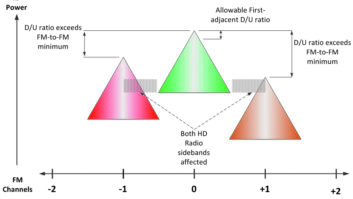WASHINGTON
Think of it as a modern-day CBS Labs.
A new Technology Research Center at NPR is intended to expand the organization’s research, consulting and testing for public radio organizations and to market those services more broadly to commercial customers.
Mike Starling, the vice president, chief technology officer and executive director of NPR Labs, will head the TRC, which operates under the auspices of the Public Radio Satellite System, part of NPR’s Distribution Division.
NPR says the center combines “the satellite transmission expertise of the PRSS with the technical innovation of NPR Labs.” In the past, NPR Labs has focused its efforts on NPR and member stations; now the Technology Research Center will be able to expand that effort to serve the entire PRSS. Those involved say the change further gives NPR Labs access to more resources and enables it to broaden the scope of its work.

Mike Starling, Ellyn Sheffield and John Kean discuss preliminary results of FM IBOC elevated power testing with attendees of the Association of Public Radio Engineers meeting before the NAB Radio Show in Philadelphia. Photo by Leslie Stimson Starling also said the center gives the broadcast industry more “research and development bandwidth.”
A prominent radio engineering executive praised the move, describing NPR Labs as radio’s only independent resource for testing, akin to the Advanced Television Test Center.
“It’s a great resource. It makes sense to take advantage of its capabilities,” said Greater Media Vice President of Engineering for Radio Milford Smith, who also chairs the standards-setting National Radio Systems Committee.
NPR Labs will retain its name but becomes a self-sustaining unit within the new center. Details were still being worked out in October.
Affinity
Given the economic climate, talks began months ago about how to increase efficiencies within NPR. There seemed to be an affinity between NPR Labs and Distribution, said Pete Loewenstein, vice president of the latter. He said both were focused on broadcast infrastructure and technology, so it made sense to align them more closely.
NPR Labs had operated as a kind of island; its personnel worked with PRSS occasionally but were not part of that division, according to Starling.
Loewenstein said managers are thinking of TRC as a new function within the Distribution division, which will be able to provide NPR Labs some back office support “for things they’ve had to do themselves” and giving its personnel more time to focus on technology research.
The Technology Resource Center, located at NPR’s Washington headquarters, will build upon the work of NPR Labs, which has conducted several studies on radio technologies — including multicasting and accessible features — for the advancement of broadcast radio technology since its inception in 2005.
“NPR Labs will become a self-sustaining unit that will continue to provide system representation and technical expertise on regulatory and legislative issues important to the station and public radio system,” the organization stated in its announcement.
“It will also focus on grant-funded work and expand its scope to include fee-based consulting services to public radio stations, industry partners and commercial clients. The TRC will serve clients by offering fee-based consulting services, including projects that address advanced broadcast coverage, listener assessment and developmental broadcast technology.”
Revenues will be used to support distribution of content to public radio stations. One official estimated that NPR Labs is “nearly” self-sustaining at present, with revenues of about $1 million a year, within NPR’s annual operating budget of about $145 million.
NPR Labs has already dipped its toe into commercial work. Starling said it completed a project for the Broadcast Traffic Consortium, of which NPR is a member along with several commercial radio groups. It conducted granular bit-rate testing of the HDC coder to confirm that the IBOC datacasting stream had the capacity for stations to offer traffic information.
The work of NPR Labs has taken a high profile in the debate over whether the industry should raise digital FM IBOC power, with NPR raising cautions about possible interference while some commercial broadcasters questioned its methods and resources.
An interesting aspect of the broadening mission for the Labs will be how and whether commercial broadcasters will put the NPR research organization to work as a contractor.
More projects, resources
NPR Labs engineers and technologists join the new center. The lab has three full-time engineers and three project-based temporary employees, as well as audio consultant Dr. Ellyn Sheffield, a professor with Towson University.
NPR Distribution has 77 full-time employees including the lab personnel. There was no net job gain or loss with the change, though Starling said the lab might someday take on more people depending on the projects it takes on.
In the new arrangement, Starling reports to Pete Loewenstein, vice president of NPR Distribution, who in turn answers to Dennis Haarsager, senior vice president for System Resources and Technology.
Starling said the research center will enable his team to expand the type and number of projects and services it can offer.
He said NPR Labs becomes connected with a unit that will help it “deliver end-to-end technology,” whereas before NPR Labs might have called upon PRSS on a short-term basis to back up a demo.
As an example of the sort of work that might be possible, Starling mentioned “a host of datacasting opportunities” in which Loewenstein’s group has expertise. For instance NPR Labs helped Vermont Public Radio parse secure school closings that their stations wanted to put up on a PAD crawl on their IBOC stream. Starling says that project may have broader appeal and NPR Labs may now be able to support that kind of project on a larger scale.
PRSS gets benefits out of the move, too. Loewenstein said PRSS is now looking at what the system will need for its next generation of hardware and software in advance of the move of NPR headquarters. Regarding codec technology in particular, Loewenstein said, “There’s expertise in the Labs group that we can tap into” as it looks into tech upgrades.









